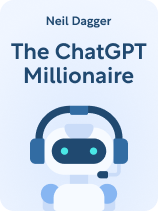

This article is an excerpt from the Shortform book guide to "The ChatGPT Millionaire" by Neil Dagger. Shortform has the world's best summaries and analyses of books you should be reading.
Like this article? Sign up for a free trial here.
How can you use an AI chatbot to generate a steady income? What will happen to those who refuse to use AI?
In The ChatGPT Millionaire, Neil Dagger explores how to leverage ChatGPT and similar AI tools to generate income by creating content, building passive revenue streams, and enhancing your freelance work. Dagger presents practical strategies for using AI to develop ebooks, online courses, affiliate marketing content, and more—with an emphasis on maximizing productivity while maintaining quality.
Read more in our brief overview of The ChatGPT Millionaire.
Overview of The ChatGPT Millionaire
In late 2022, ChatGPT burst onto the scene, quickly amassing millions of users who were fascinated by the AI tool’s ability to quickly draft emails, explain concepts, and generate creative text. Shortly after its release, a wave of books aiming to help readers capitalize on this new technology flooded the market, among them computer scientist Neil Dagger’s The ChatGPT Millionaire (2023). Dagger, who holds a BSc in Computer Science from University College London and writes a blog called “Retire Decades Early,” presents ChatGPT as a revolutionary tool that can help content creators, freelancers, and entrepreneurs increase their productivity and potentially generate significant income.
Dagger suggests that those who quickly adopt and master generative AI (technology that can create content like text, images, or code from simple prompts) will gain a competitive advantage, while those who ignore it risk being left behind. The ChatGPT Millionaire reflects the initial excitement around ChatGPT when the technology was novel. Reviewers note that the book primarily offers basic information about ChatGPT and how you can use it, rather than providing detailed strategies for monetizing the technology.
What Is ChatGPT, and How Does It Work?
Dagger explains that ChatGPT is a versatile, text-generating AI tool. It’s powered by a large language model (LLM) that generates responses based on patterns it learned during training on vast text datasets, rather than searching the internet for answers like a search engine would. Dagger characterizes ChatGPT’s versatility as its primary value: It can write essays, generate marketing copy, create code, draft emails, and perform many other text-based tasks.
Dagger focuses mainly on what ChatGPT can do rather than explaining how the technology works behind the scenes, and many of the technical details he does mention have evolved since the book’s publication. However, Dagger identifies three key limitations of the tool: its reliance on training data, its limited context window, and its difficulty with ambiguity. In the following sections, we’ll take a closer look at each of these limitations.
ChatGPT Learned Patterns From Its Training Data
The first limitation that Dagger explains is that ChatGPT’s training data (at the time of writing) only extended to 2021, which means that the model lacked knowledge of more recent events. He points out that the version of ChatGPT available when he wrote the book couldn’t access current information or search the Internet in real time.
The Model Has a Limited Context Window
The second limitation that Dagger explains is that ChatGPT works within a limited “context window”—approximately 32,000 tokens (or 25,000 words) in GPT-4—which restricts how much conversation history it can reference when generating responses. Dagger notes that the finite context window means users need to break longer projects into smaller components or prompt the AI to continue where it left off. Sometimes, a ChatGPT response cuts off mid-sentence. This often means the model has reached its maximum token output for a single response.
ChatGPT Can Have Trouble With Ambiguity
The third limitation that Dagger explains is that ChatGPT and similar models can misinterpret ambiguous language or nuanced requests, which means that you need to provide precise instructions to get the best results. He emphasizes that the quality of the output you get from ChatGPT depends significantly on the quality of the input you provide—a principle that becomes central to Dagger’s monetization strategies, as we’ll see later in the guide.
Why Should You Use ChatGPT for Content Creation?
According to Dagger, the primary benefit of integrating ChatGPT into your workflow is efficiency. He suggests that the tool can dramatically speed up tasks that would typically take hours or days to complete manually, regardless of your profession or industry. ChatGPT can serve as a partner for refining your ideas and as an efficient production assistant. For example, imagine that you keep a daily blog (or that you post a video every day on TikTok), and you sometimes struggle to come up with enough ideas. ChatGPT can propose topic ideas, outline your chosen concept, draft a full post or script, and revise it based on your feedback—all in a fraction of the time it would take for you to complete these tasks independently.
Dagger also writes that ChatGPT’s adaptability across different content types makes it particularly valuable. Whether you’re creating marketing copy, composing books, building code, or developing specialized content (like meal plans or fitness regimens), he contends that you can use ChatGPT to create the kind of content you need. For example, educators might generate quizzes and lesson plans, nutritionists could create personalized diet recommendations, and developers might write and debug basic code snippets—all potentially saving time on routine tasks.
Dagger cautions that ChatGPT works best when augmenting skills you already have rather than replacing human expertise. In practice, this might look like a marketer using ChatGPT to generate drafts of email campaigns based on messaging points they’ve developed, or a blogger having ChatGPT draft a post while they focus on infusing the final piece with their unique voice and perspective. The human provides the strategic direction and specialized knowledge to guide the process while the AI handles repetitive, time-consuming elements. Dagger contends that by treating ChatGPT’s output as a starting point rather than a finished product, you can maintain high standards of quality while dramatically increasing your output capacity.
How Can You Use ChatGPT Effectively?
Dagger offers a basic framework for maximizing the value you get from ChatGPT, centered on using strategic prompting techniques. His core principle is straightforward: The quality of output directly correlates with the quality of input you provide. He outlines several key approaches to improve your results when using ChatGPT, which we’ll take a closer look at in this section.
Prioritize Clarity in Your Prompts
The first strategy that Dagger recommends is writing clear, unambiguous instructions that explain the task in terms that AI can understand. Before engaging with ChatGPT, he recommends having a well-defined goal for what you want to accomplish. Being specific about your requirements—including the tone, format, and length of the response you want, as well as the purpose of the desired response—helps the model generate more relevant content. This advice remains practical regardless of which version of ChatGPT or similar AI tool you might use.
Tell GPT What Role to Assume
A second technique Dagger highlights is the “act as” method. By instructing ChatGPT to “act as” a particular professional—such as a marketing expert, novelist, nutritionist, or programmer—you can elicit responses that better align with industry standards. This approach effectively taps into the model’s training on content that was originally created by experts in various fields, resulting in more specialized and appropriate outputs.
Ask for Multiple Options
A third strategy Dagger suggests is that rather than settling for a single output, you can request several alternatives simultaneously. For example, instead of asking ChatGPT to write a single headline for a blog post, an email subject line, or a product description for your Etsy store, you can prompt it to create several alternatives and try out different angles on the same idea. This gives you the ability to exercise your judgment in selecting the most effective option or combining elements from different versions. This technique acknowledges that the first AI-generated response isn’t always the best one—and that LLMs “think” by writing.
Always Save Time to Review and Edit
Fourth, Dagger cautions against using ChatGPT’s output without closely reviewing its writing yourself. He suggests that you should make a practice of treating AI-generated content as a first draft that needs checking for accuracy, tone, and style, rather than considering it a finished output.
Break Tasks Into Smaller Pieces (and Prompts)
For complex projects, Dagger advises breaking tasks into manageable parts rather than attempting to accomplish everything with a single prompt. This incremental strategy enables you to take a hands-on approach to guiding the development of longer content and to provide the model with feedback on its work at each stage. For example, if you’re writing a book, you might start with prompts about the overall concept, then move to chapter outlines, and finally to drafting individual sections—reviewing, refining, and providing ChatGPT with valuable guidance at each step of the process.
How Can You Make Money With ChatGPT?
Finally, Dagger outlines strategies for leveraging ChatGPT to generate income based on how he thinks AI tools and usage will evolve. He presents two primary approaches: creating passive income streams and enhancing freelance work.
Generate Passive Income
Dagger cautions that simple, quickly-completed ChatGPT tasks will rapidly oversaturate markets as more people discover these opportunities. He suggests that AI’s greatest potential lies in more complex projects because higher barriers to entry create more sustainable opportunities. While anyone can use ChatGPT to generate a simple product description or social media post, creating a comprehensive ebook, detailed course, or functional app requires deeper subject knowledge, technical skills, and sustained effort. The passive income opportunities Dagger identifies include:
Writing Ebooks
Dagger suggests ChatGPT can help research topics, outline chapters, draft content, and create marketing copy to sell ebooks on platforms like Amazon. At the same time, he acknowledges that developing a truly valuable book requires careful curation and multiple iterations.
Producing YouTube Content
Dagger describes how ChatGPT can help identify potential video topics with high search volume but low competition, then generate scripts you can use to create videos. If you have an established presence on YouTube, you can monetize these videos through advertising, sponsorships, or product promotions.
Creating Affiliate Marketing Blog Posts
According to Dagger, ChatGPT can help you craft product comparison articles or buying guides that incorporate affiliate links. He suggests focusing on niches where you have expertise, which would enable you to evaluate and supplement ChatGPT’s output. For example, a fitness enthusiast might use ChatGPT to help draft reviews of exercise equipment they’ve personally tested, adding their own insights and experiences to make the content more authentic and valuable.
Building Online Courses
Dagger writes that online courses potentially offer the highest return on investment. ChatGPT can help structure courses, develop lecture scripts, create supplementary materials, and design quizzes. He mentions combining ChatGPT with other AI tools (like Pictory, which can help you convert scripts into videos) to streamline production.
Writing Code and Apps
For those with a technical background, Dagger suggests ChatGPT can generate functional code, create documentation, test for bugs, and help troubleshoot issues. This application remains relevant, though ChatGPT is better suited for helping with specific coding problems than generating complete, production-ready applications.
Enhance Your Freelance Work
In addition to generating passive income, Dagger suggests that freelancers can use ChatGPT to increase productivity by automating routine aspects of their work. Whether for translation, copywriting, or content creation, ChatGPT might help you produce initial drafts more efficiently. Dagger maintains that combining ChatGPT’s efficiency with human expertise creates more sustainable monetization strategies.

———End of Preview———
Like what you just read? Read the rest of the world's best book summary and analysis of Neil Dagger's "The ChatGPT Millionaire" at Shortform.
Here's what you'll find in our full The ChatGPT Millionaire summary:
- How to leverage ChatGPT and similar AI tools to generate income
- Why it's so important to prioritize clarity in your prompts
- How to make a profit using ChatGPT in an oversaturated marketplace






